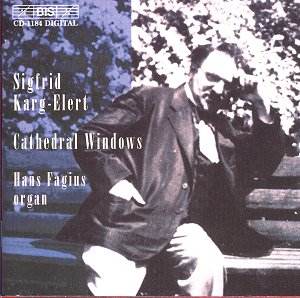The German composer Sigfrid Karg-Elert is one of the
most important composers of his time and his organ music stands high
in the literature of that instrument. He wrote more than two hundred
compositions for the organ not to mention his other works for chamber
music, piano and voices as well as pieces for harmonium, the demanding
keyboard instrument of the 19th century. The following quotation
expresses his preference for this instrument, which dominated his life
as a performer and as a composer for more than ten years: "The
Kunstharmonium with its capacity for expressiveness, its wealth of differentiation
of tone and its technical perfection became the instrument which met
my highly strung artistic demands."
His first compositions for organ were actually arrangements
of previous harmonium pieces. His compositional style was strongly influenced
by Debussy, Scriabin and Schoenberg. Thus his musical language is chromatic
with complex key modulations and relationships. Despite this the result
deliver a warm melodic line. His detailed organ registrations, as Hans
Fagius points out in the booklet, are "…highly original with their
bright and transparent world of timbres; a world that distinguishes
itself from the usual late-romantic style."
The Symphonic Chorales were published in 1913. The
second chorale Jesu, meine Freunde is dedicated to Karl Straube,
the distinguished organist of Thomas Church. It has a symphonic structure
and a variety of dynamics and different forms. The canzone in G flat
is referred to in the booklet as "…very probably a transcription
of the middle movement from the large Sonata on BACH for harmonium,
Op. 46, published in 1912." The Cathedral Windows, which
were published in England in 1923, are based on Gregorian tunes and
they are referred to by Karg-Elert himself as being in "a pure
organ style". The mood is highly impressionistic with all the melodies
associated with Christmas. The symphony in F sharp minor, from 1930,
was never published during his lifetime. It was discovered in 1984 and
printed in 1987. It is a long and technically demanding piece played
without any break.
Fagius’s approach to the music of Karg-Elert is very
well presented. He deals tastefully with the different forms and styles
and maintains appropriate energy all way through. He plays with plenty
of virtuoso fire, balanced with the necessary expressive treatment.
His sense of rubato produces nice melodic lines, even though occasionally
a greater sense of space would help the organ to fill the acoustic.
Also a wider variety of touch would help the expressiveness of the lines.
The registrations are well chosen according to the composer’s wishes.
The musical effects produced in the magnificent acoustic of the cathedral
by the Frobenius organ are stunning.
The booklet with Fagius’s notes is very well written
and forms a necessary accompaniment to the CD itself. In general, this
release is one to covet.
Christina Antoniadou


